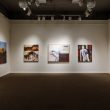Séamus Gallagher knows better than most how cringeworthy it can feel to call yourself an artist and how imposter syndrome can creep in when that’s the reply to a stranger’s asking what you do. But when I ask them the moment they knew for sure they were an artist, they don’t miss a beat delivering a time and date: Moncton, New Brunswick, 2011. The feeling was a thrum in their bones that matched the sound of their computer connecting to the internet, sharing their earliest works—“pop culture-based drawings” inspired by the TV series Twin Peaks—on Tumblr.
“They’re not, like, drawings that I’m particularly proud of at this point,” says Gallagher, recalling their teen years. “But that was my starting ground for connecting my interests, and translating them through drawing, and then sharing them with others.”
When Gallagher takes my call from Visual Arts News, it’s a moment that feels if not full circle, at least oblong or loopingly oval. These days, their practice once again has them tucked away and experimenting with new forms of expression—not quite the same as finding their voice, but certainly exploring its registers. The difference now, of course, is that their Moncton bedroom is far away both in geography and memory as Gallagher sequesters themselves in their studio at Carnegie Mellon (yes, the same school Andy Warhol studied at). And this time around, the David Lynch references have been replaced by Gallagher trying new-to-them mediums like silicone, casting, and ambient sounds, fighting burnout and expanding their practice with pieces that may never see the light of day but will recharge their creative battery.
“I feel like there’s a bit of a friction that I’m trying to unlearn, like, allowing myself room for failure without trying to sort of theorize everything and try to fit it into the next Canada Council Grant,” says Gallagher.
While Gallagher remains delightfully down to earth, the road between these two creative enclaves has been studded with success for them from the very beginning. At NSCAD, their Day-Glo-bright self-portrait photos (emblazoned with sentiments of climate anxiety and existential dread) made them stand out from the rest of their undergrad class, nabbing the school’s prestigious Starfish award in 2018. Soon, video, photo, and VR-based works that mixed video game culture and drag saw Gallagher demolish the wall between so-called high- and lowbrow—without chipping their signature stiletto manicure. The effort landed them on the 2023 Sobey shortlist, pausing en route only to snap up prizes like the noteworthy New Generation Photography Award in 2021. Lately, it’s also taken them to Montreal’s McCord Museum, where their solo exhibit Mother Memory Cellophane was on view from September 8, 2023 to February 4, 2024.
“What I find inspiring is looking at my many different interests and finding ways of linking them together and creating, like, a mapping of my interests, and threading disparate sources of inspiration, and then creating projects out of those inspirations,” Gallagher says.
They name internet-age philosopher Mark Fisher; the nonbinary, 1920s surrealist artist Claude Cahun; and multidisciplinary artist Sondra Perry as some of the evergreen creatives they look up to. “I have a visual sensibility that tends to be pretty campy, or over-the-top. So, I take a lot of inspiration from maximalist video game aesthetics and also, like, just drag as an art form.”
This is perhaps proven nowhere better than their recent McCord Museum show. Mother Memory Cellophane is inspired by the 1939 Dupont model who debuted nylon stockings. Gallagher takes this twentieth-century lightning rod of glamour and distorts it: 3D heads sprouting diamond-shaped tears the size of a forearm spring from this version of Miss Chemistry; later, she sits on a throne surrounded by foiled balloons of stocking-and-stiletto-shod legs.
I ask why drag and camp—both hallmarks of the show, creating a frisson that hooks the viewer—are such fascinations for Gallagher. “I think it’s kind of been embedded in my work,” they begin. “While I was developing this process of creating these characters and masks and costumes, I thought they were so gorgeous and stunning—the most beautiful thing in the world. And then the response was like, ‘There’s a real creepiness to it.’ Which wasn’t my intended response.” They laugh and continue: “So I think it’s just, like, always been the way I’ve just seen the world and moved through it has been with, like, the sincere attempts of, like, creating something beautiful, but then my idea of beautiful might not be others’ as well.”
Somehow, looking over the compelling, twisted vision that Gallagher continues to deliver, I can’t help but feel David Lynch himself would politely disagree. Isn’t a unique perspective one of the rarest beauties of all?
“I feel like this idea of a copy of a copy—like simulacrum and, like, cheap imitations—are things that have returned in quite a bit of my work. And the idea, that sort of definition, of camp as being the sincere attempt to reach this heightened form of glamour and desire that’s, like, not really attainable, it’s so sincerely trying to reach this bar [and] it fails so spectacularly that this new visual language is created that we refer to as camp,” says Gallagher.
I have to interject, asking them if they feel that today, camp has become a sort of cultural shorthand to defend the things we know are disposable but love anyway (Is, for instance, reality TV campy? Or merely *not* prestige TV?). “Maybe, but I kind of love that though,” they say, a laugh as bright as their preferred colour palette lighting up the phone line. They reference supermodel Karlie Kloss’s flop during the 2019 camp-themed Met Gala (“It’s camp by definition of not understanding what camp means,” they say). A breath passes. “Just, like, thinking of the celebration of failed copies is a thread throughout my work—and maybe throughout the way I live my life: thinking about seeing cheap imitation—and these things that are seen as inherently negative—as something to be celebrated.”









Leave a Reply